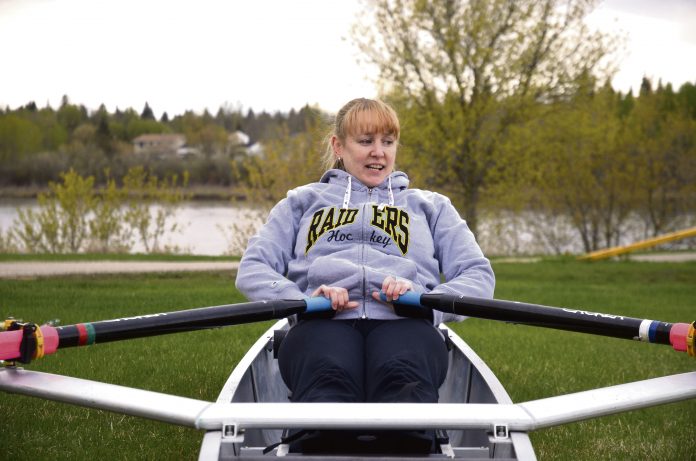A little-known club is trying to build its membership and try what they say is an “addicting” sport.
The Prince Albert Drifters Rowing Club held an open house last week with the hopes of getting people to come out and learn how to row.
The club has been around for years. It was started in the 1970s, and at one point boasted a very strong membership. Several youth learned how to row on the North Saskatchewan River. Some went on to national, and even international competition. As the youth grew up and moved out of P.A., the club’s membership dwindled. Now, led by chair Shannen Fisher, the club is out to reinvigorate itself, and it’s focusing on building a strong base of adult members to keep the group growing.
Last year the club had 28 members. Now, they’re hoping to grow that to 40.
“Right now it’s just 18 and over, and a part of that is because of water safety issues,” Fisher said.
“It’s a sport a lot of people learn later in life. Once the club is built up, and if we’re ready to go, we would look at working with youth. It would be 12 and over, because you have to be a certain height to get into the boat.”
Fisher herself only started rowing three years ago. Now, she’s a coach, chair, and dedicated regular during the summer months out in a boat on the river.
“I heard about the rowing club and thought I would give it a shot. I loved it the first time I was out on the water,” she said. “I just thought it was so amazing. I’ve been doing it actively every summer since.”
Part of the appeal is the beautiful views the activity offers. All it takes is a short trip west to be surrounded by wilderness.
“I think the river is under-utilized,” Fisher said.
“It’s Prince Albert’s best-kept secret. When you head out west, right away you’re out in nature and you see a lot of wildlife, and some beautiful scenery. You get a really good workout as well.”
It’s no gentle paddle, though. Rowing is a lot of work. It’s nothing like going for a quiet canoe trip.
“Rowing is a full body workout,” Fisher said. “We engage all muscle groups. It’s great cardio, and it’s low impact.”
Fisher used to be a runner, but she had to stop because it’s a high-impact activity. Rowing quickly filled the gap.
“If you’re looking for an experience like canoeing or kayaking you might be a little disappointed with rowing. We find people who enjoy CrossFit really like rowing as well, because of the intensity of the workout,” she said. “It can be a lot more relaxed if you want it to be, but it can also be a pretty extreme workout.”
Beginner rowers learn the basics on land before they ever hit the water.
The first step is to learn the basics on a rowing machine, just like the kind you would find at a gym. Newcomers spend a lot of time on the machine, until the motion becomes more like instinct, and muscle memory takes over.
Introductory work is also done in a boat on dry land, so rowers can practice getting in and out of the boat, understand the boat’s mechanics, and the finer points of a rowing stroke.
“When a person’s ready, we take them out on the water, Fisher said. “You’ll be in a boat with at least one experienced rower for some one-on-one time. We just build it from there.”
Once a new rower is ready to hit the water, they’re faced with a new challenge – finding their balance.
Unlike a canoe or kayak, a rowing shell is long and narrow, making it much less stable on the water. Newcomers spend their first year or two on a trainer boat, which is fairly stable, before moving on to the narrower, competitive boats.
“Learning to row is a little like learning to ride a bike,” Fisher said. “Balance is really important. It’s deceptively easy. Everyone knows when you’re first learning to ride a bike, there’s a lot going on.”
Even more experienced rowers spend a lot of time learning on dry land.
“It’s like your golf swing,” Fisher said. “Even Olympic rowers aren’t perfect.”
Just like Olympic rowing, there are different sizes of rowing shells for different numbers of people. The club mainly spends time in doubles and singles, but they also have three four-man shells, and one designed for eight. As all rowers in a boat needs to be of similar size and skill level, it’s rare the club is able to get eight people into one shell.
For most of the year, the club members just row recreationally. But twice a year, they have the opportunity to test their skills against others in the province.
“We start with recreational. It’s about going out onto the river and having fun,” Fisher said. “If people want to take it to competitive (rowing), they sure can. There are two regattas in Saskatchewan people can compete in. I did one last September. I survived, and this year, I’d like to try again, because competition is a whole different art form.”
The club has good relationships with groups in Saskatoon, Regina and Lloydminster, so even the competitions are fun, social affairs.
Introduction to rowing classes run Tuesdays and Thursdays, or Mondays and Wednesdays from 5:30 – 7:30 p.m., after the May long weekend. But if that doesn’t work for people, Fisher said one of the four coaches might be able to find another time that works with their schedule. The group can be contacted over Facebook, or by emailing Fisher at shannen1975@me.com.
“If you’re not sure about it, at least come check out the boat house (located on River Street West) and ask for a tour,” Fisher said. “We find it really is an addictive sport.”


